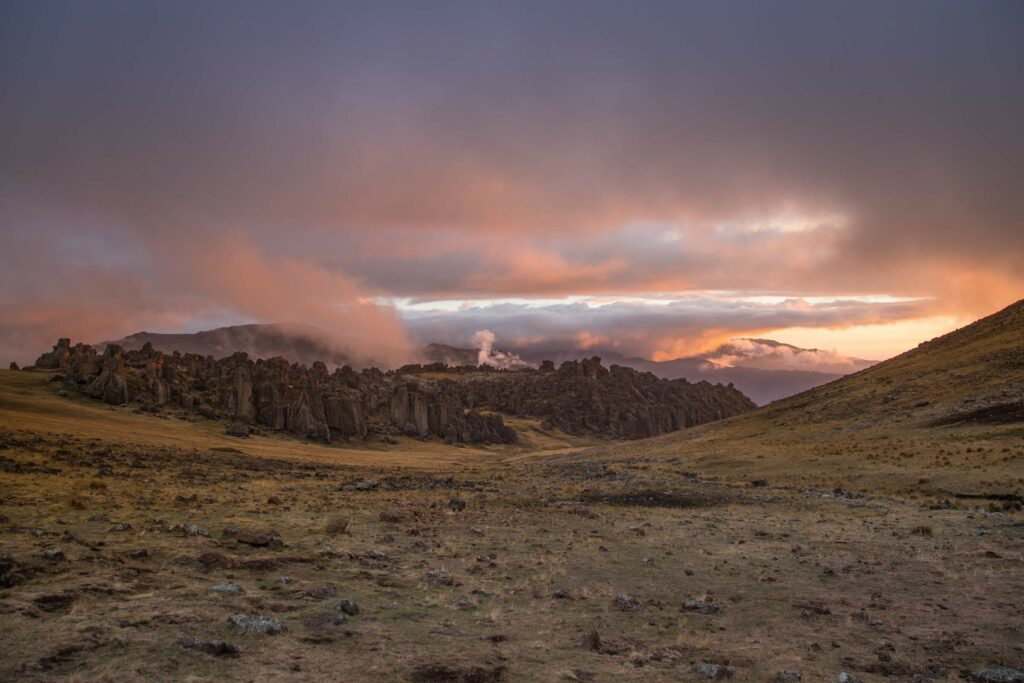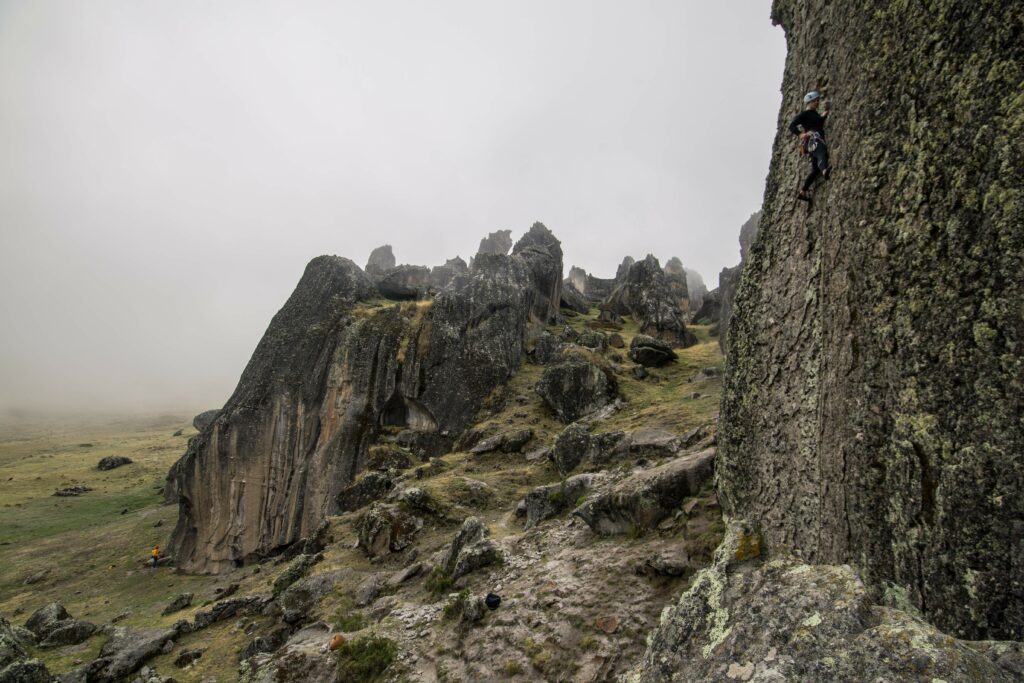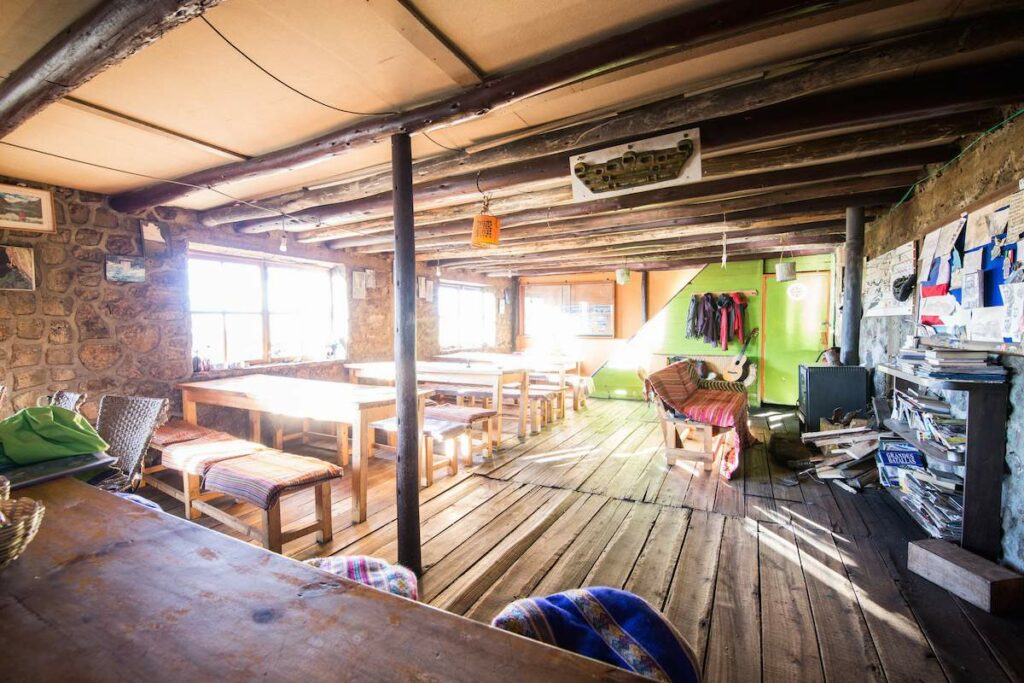Hatun Machay is a remote, high-altitude (14,000 ft!) sport climbing, hiking, and cultural playground, about two hours outside of Huaraz, Peru. With over 400 bolted routes, counting, and seemingly unlimited bouldering you could spend weeks there without repeating a climb. The sunrises, sunsets, and alpine hiking are stunning enough to attract non-climbers.

That said, you’ll be almost entirely removed from civilization, including internet, and even consistent power supply (they run the power a few hours at night in the Refugio), which I really relished, but you may want to bring a good book, a sketch journal, and a desire to find supreme relaxation.
Check out more climbing news here!!!
How to Get There
From Lima to Huaraz: (8 hours by land or 50 min by air)
You’ll probably want to spend a few nights acclimatizing and shopping for food in Huaraz (which is already at over 10,000 feet) before continuing on to Hatun Machay. You may also want to take advantage of the fabulous trekking and world-class mountaineering near Huaraz before or after your time at Hatun Machay. We opted for two short acclimatization hikes (Laguna 69 and Laguna Churrup) before heading to Hatun Machay, and a longer multi-day trek (Santa Cruz trek) afterward.
- Bus: Multiple departures per day head to Huaraz from Lima, including a daytime (views, views views!) and overnight option. It’ll take about 8 hours and cost around $20-50, depending on the time and service level you choose. There is everything from a standard “coach” bus to a “luxury” VIP with cushy seats that recline and meals. The two most popular companies are Cruz del Sur and Movil Tours.
- Car: If you’re in Peru for a longer stay, and found a great rental deal on a car (or bought one!) you could definitely drive. This is probably a bit overkill if you’re just headed to Huaraz and Hatun Machay. If you do drive, do so during daytime hours since the roads are mountainous and winding.
- Plane: LC Peru flies directly from Lima to Huaraz. The flight is approximately 50 minutes, and the main limitation will be price and weight restrictions (they only allow 15 kg checked, 5 kg carry on), though this could be a good option if you want to save time.
From Huaraz to Hatun Machay: (1.5 hours)
You Have A Few Options Here, Including:
- Taxi direct from Huaraz to Hatun Machay (unsure of the total price, but everything is cheaper in Peru and you can probably bargain this down).
- Cambio to Catac ($1-$1.50/5s per person), taxi uphill direct to Refugio ($15/40-50s total), or taxi to the road (5s) with a 2-hour walk uphill.
- There also may be a shuttle from Huaraz to Hatun Machay through the Andean Kingdom, however, this was not running when we were there.

The author on a warm-up climb at La Placa Verde sector
Where to Climb: Hatun Machay
The Refugio is perfectly snuggled within a very short hike of the climbing, anywhere from 5 minutes to 30 minutes. It may be a bit hard to scope routes too far in advance since the online route information is quite limited: Mountain Project and the Crag both list some of the most popular routes, but there are many others that we enjoyed. For a gorgeous guidebook of all the climbs in the greater Huaraz area, including Hatun Machay, buy this one in town. The Refugio also has guidebooks you can borrow while there.
Keep in mind they’re adding new routes *all* the time so it’s easy for books to become out of date pretty quickly. When we were there at the end of 2015 there were over 400+ sports routes, in over 23 sectors, mostly single pitch but also some multi-pitch, and nearly infinite bouldering. We stayed on the easy to moderate routes since we were a bit out of shape climbing-wise, but anyone from intermediate to advanced should be able to find stuff to play on.
Classic climbs at La Tapia (the second closest sector to the refugio) include: Mirar Primero, Escalar Despues (23m, 5+/5.10a), Fancy a Good Route (14m, 6b+/5.11a), Apnea (14m, 7c/5.12d).
Wait Here is More…
We also enjoyed or were recommended Pincitas (27m, 6a+/5.10c), an overhung arete climb that follows the left side of the cave at La Cueva, Welcome to Huaraz (23m, 6b+/5.11a) at La Fisura, Rasta Quechua (45m, 6a+/5.10c) at Rasta Quechua sector, and the really interesting honeycomb features in general at Fideo Brinchero sector.
The climbs facing the Refugio (which will get sun toward the afternoon) are definitely more traveled, and as a result a bit cleaner, with higher rock quality. Spend a day or afternoon walking around and appreciating the sheer amount of rock, with varied features from overhung to slabs, pockets, huecos, stemmy problems, and aretes. We also spent some time on the climbs on the less-traveled back side (facing east) and found interesting climbs, but if you head that way definitely scope routes before starting and wear your helmet!
As is common at crags and Refugios, the other climbers at Hatun Machay were all incredibly friendly. A great way to get the scoop on beta is during the evenings in the Refugio, over dinner or hot tea.
When to Go Hatun Machay
The peak season (dry season) for Hatun Machay and the Peruvian Andes lasts from May-September. The rainy season starts in November, however, we were there at the end of November (we spent Thanksgiving there!) into December and still had an amazing time. It rained almost daily but we were able to get up early, climb in the mornings, and finish up midday, ready for some tea and a snuggle by the fire. I prefer less crowded times so would likely try and head there from October through November for the shoulder season. Just make sure you bring good waterproof gear, a good tent if you’re planning on camping and warm layers.

The view from the Refugio.
Where to Sleep, Refugio is The Only Option
If you’re at Hatun Machay, you pretty much only have the option of staying at the Refugio. But this is good news– the outhouse and Refugio are cozy and well-kept. The couple watching the Refugio are some of the nicest people we met on our travels. There’s a nicely outfitted kitchen, hot shower, clean drinking water from the tap (or filter if you want), and constantly-refilled hot water in thermoses available for tea. Each group gets a food storage bin to keep their food secure.
At nighttime, they light the wood-fire stove, and people sit at the long tables eating, sharing stories from the day, teaching each other games, and reading. Even without the climbing, it would be a lovely, cozy place to spend a few days or a week.
You have the option of staying in the bunk beds upstairs or camping:
- Stay at the Refugio: (35s/~$12 per person per night): Cozy beds, with down blankets for an extremely reasonable price. I’d probably still want a sleeping bag in case I got cold at night since I heard some people saying it got chilly. The biggest downside is you’ll have to go outside to get to the bathroom.
- Camp outside: (20s/$7 per person per night): We were the only people camping when we visited at the end of November/early December since it’s only a few dollars more to stay inside. It rained on us daily and hailed once, but if you have a good waterproof tent and layers (and warm sleeping bags!) you’ll be fine and it’ll be a fun adventure. We had a Black Diamond tarp tent and stayed warm and cozy the whole time.
Another option is to camp out by the crags, but you won’t have access to water, heat, etc. so this likely would be a short-term option. We considered doing it one night so we could get better sunrise/sunset photos but the view from the Refugio is pretty amazing.

Inside the cozy Refugio, with wood-burning fireplace, plenty of seating, and a kitchen with potable water, and unlimited hot tea.
Where to Eat
You have two options to feed your hungry pre/post climbing belly at Hatun Machay:
Bring your own food: This is the more popular option since you’re likely getting a ride directly to the Refugio, and food is cheap in Huaraz at the supermarkets or market. We got some nicer items and spent something like $45 total for all our food for four days for two hungry people. There is no refrigeration but things like yogurt, cheese, and eggs were totally fine staying out.
Buy at the Refugio: There’s a limited food selection at the Refugio, including ramen, chocolates, some fruit, eggs, beer, and wine! You can also ask the Refugio caretakers, Miguel and his wife Isabella if they can pick up items for you on a run to one of the local villages. We extended our stay and Miguel brought us back yogurt to supplement our remaining food.

Hatun Machay is a sacred and protected area that locals visit and use. While there, we bought food from and chatted with this sheep-herder couple who speak mostly Quechua.
Rest Day Activities
At the Refugio: The rock at Hatun Machay is very sharp and so you’ll probably want a day or two to rest your now fingerprint-less fingers. Unless you drove or want to hire a taxi for the 1.5/2 hour ride back to Huaraz, you’ll want to spend your rest day near the Refugio. Hike around the crazy boulder fields (it’s pretty large so make sure you bring enough water in case you get lost, which we did when the fog rolled in!), and check out the cave paintings (don’t touch!).
We also met (and ended up buying a sheep from!) the couple pictured above who spend part of the season at Hatun Machay with their herd. Miguel, an archaeologist who works at the Refugio and studies the cave paintings and history of Peru, knows all the best views in the area so he’s a wealth of information if you want a specific view (best place for sunrise/sunset, etc.).
Useful things to know:
- Unlike Argentina, where gear is very expensive to buy or rent, we found gear in Peru to be quite reasonable if you don’t feel like bringing it along. You can rent gear either at the Refugio (when we were there everything including rope, 15 quickdraws, harness, shoes, and belay device were around 70s/ ~$23 or so for two people per day) or in Huaraz (go to the main square, ask around, and haggle if you have time. We got all of our gear for two people for something like 150s, or $10 a day. They will probably give a discount if you rent longer). One thing to note is to make sure you request helmets. I’m not sure if the Refugio rents them and we had to be firm about wanting two helmets!
- A 60 m rope is fine, 70m may be better. We rented a 60 and were fine with rope stretch but some of the other climbers had “a 60m” that wasn’t long enough on the longest climbs.
- You won’t be able to get cash at the Refugio. Make sure you have extra soles to buy things at the Refugio and enough for transportation both ways to Huaraz.
- If you have extra space in your bag, especially if you’re going during shoulder season, it might be nice to have a portable thermos so you can have hot drinks/tea at the crag.
Let Miguel and Isabella know Matt and Amanda sent you. We hope to be back someday soon to that magical place!
Amanda Winther is a San Francisco-based marketing consultant, freelance writer, life-long learner, avid podcast listener, travel addict, and lover of all forms of outdoor adventure, especially rock climbing, backpacking, and more recently mountaineering. She and Matt just returned from 4 months of traveling through South America. She hasn’t gotten around to blogging about it yet but will! Follow along on Instagram or Facebook.
Matt Swartz is a freelance photographer and digital artist working in advertising and living on the Westside of Los Angeles, where he can be found enjoying craft beers, honing his welding skills, or jogging along the ocean. He has climbed, hiked, and biked all over the American West. To find more photos like the ones in this article, visit his website at www.mswartzphoto.com, or follow him on Instagram.
Climb on!
Amanda






